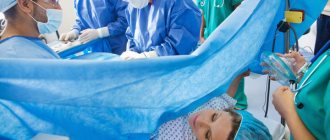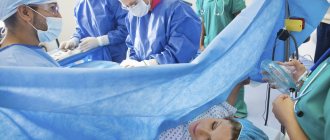After natural childbirth, a woman’s body is always weakened and susceptible to various types of infections. What can we say about surgical delivery - caesarean section, which in itself is stressful for the body. Many expectant mothers needlessly underestimate the seriousness of this surgical intervention. Meanwhile, after it there is often an increase in temperature, which can be caused by completely “harmless” or pathological factors.
- 2 Postoperative temperature readings are normal
- 3 Pathological causes of fever after cesarean section
3.1 Photo gallery: diseases that can cause hyperthermia after cesarean section
Rules for measuring temperature
A caesarean section is a full-fledged surgical operation in which the muscles of the abdominal cavity and uterus are dissected in order to extract the fetus from a pregnant woman. At the moment, this manipulation is not new and is well common. During the period after surgery, a woman needs to carefully monitor her own well-being, follow all recommendations given by the doctor, in particular, regularly take temperature measurements.
You should start measuring your temperature after a cesarean section the very next day after surgery, and this should be done four times a day. Measurements should continue as long as the woman is in the maternity hospital. The obtained indicators must be recorded, indicating the specific time of measurement. This approach allows you to track dynamics.
It is important that the temperature should be measured by placing the thermometer under the tongue, and not in the armpit (the temperature in this place will be increased in any case, due to the onset of lactation).
To obtain reliable results, the woman is recommended to lie down for about 15 minutes before the measurement procedure to calm down. Emotional overload and physical activity are quite capable of causing an increase in temperature. The use of an electronic thermometer remains preferable.
After a woman is discharged, she should continue to monitor her body and measure her temperature if the slightest signs of illness occur.
What should the temperature be after a cesarean section?
How can you reduce your temperature after surgery while breastfeeding?
First of all, it is necessary to understand that in the event of an increase in body temperature and a deterioration in the general condition after surgery, it is strictly forbidden to self-medicate. The regimen is developed only by a doctor after determining the exact diagnosis and depending on the individual reactions of the young mother’s body to medications.
A woman should not endanger her health and life. Untimely detection of peritonitis or sepsis in some cases leads to death.
Among the medications that are used to treat complications after surgery, not only broad-spectrum antibacterial drugs are prescribed, but also medications with anti-inflammatory properties . Often a woman is recommended treatment in a hospital setting in order to constantly monitor her condition and prevent the situation from worsening. If doctors have diagnosed an infection in the suture of the abdominal cavity or uterus, another operation is possible, during which the surgeon will clean the tissues of pus to cope with the infection.
In the case when a young mother’s body temperature has risen sharply at home and she is waiting for an ambulance to arrive or is planning to go to the doctor on her own, you can normalize the condition and prevent an increase in the readings on the thermometer scale with the help of antipyretic drugs. Nursing mothers are allowed to use drugs based on paracetamol or ibuprofen in children's form (syrup):
- Panadol for children;
- Efferalgan;
- children's Nurofen;
- Ibuprofen.
Doctors warn that the temperature should not be brought down below 38 degrees, but if the readings rise higher, it is better to take medicine. Preparations based on ibuprofen not only quickly cope with fever and relieve pain, but also have anti-inflammatory properties.
Photo gallery: drugs with antipyretic properties
Ibuprofen has not only antipyretic but also anti-inflammatory properties
Nurofen - antipyretic syrup with orange and strawberry flavors
Panadol for children is available in the form of a syrup with a pleasant taste.
Efferalgan contains paracetamol and is effective in reducing fever
Doctors warn women who have given birth to children via cesarean section that they must carefully monitor their condition during the period of recovery of the body and healing of the suture. The fact is that any surgical intervention can cause complications. It is precisely because of the risk of wound infection that you must observe the rules of personal hygiene and follow all the doctor’s recommendations. If a young mother notices that her temperature has risen, a specialist should be informed about this. Perhaps this condition is an individual reaction of the body and this is the norm for a woman. But more often, a figure of 38 or higher on a thermometer signals that an inflammatory process has begun, which must be treated as soon as possible so as not to trigger the disease.
Normal temperature readings in the postoperative period
After a cesarean section, a woman often experiences a slight increase in temperature. This situation is considered normal. Many people are interested in how long the temperature lasts after a cesarean section. During the first day, temperatures can reach 38 degrees. This hyperthermia is a natural reaction of the body in response to major surgery. On the second day after cesarean section, the readings drop to 37-37.5 degrees. These indicators last for about 7-10 days, then return to normal. But some women may experience an elevated temperature to a subfebrile level for a month. This is due to the individual characteristics of the organism.
Temperature after cesarean section is a natural reaction provoked by harmless factors not related to the addition of infection:
- Dehydration of the body.
- Hormonal changes. After pregnancy and childbirth, the female body begins to restore its hormonal levels.
- Use of medications. Under the influence of some of them, blood circulation improves, which, in turn, can provoke a slight increase in temperature.
- The formation of lactation and the beginning of the process of milk production.
- Emotional stress in a young mother, which is caused by the awareness of the past operation and the birth of a child.
- The beginning of the healing process of sutures. Minor hyperthermia helps accelerate metabolic processes and speedy tissue regeneration.
Physiological reasons
Fever after cesarean section is a normal reaction of the female immune system to surgical intervention. Normally, it should be short-lived and be at subfebrile levels - 37.0-37.8 degrees. If the postoperative period proceeds normally, the temperature returns to normal within 1-2 days after the operation.
Childbirth on the surgical table cannot be considered natural, physiological. Therefore, for a woman’s body, a cesarean section is a great stress, the reaction to which is usually a slight rise in temperature in the first day or two after the intervention.
But the body’s adaptive abilities are quite high and the immune system quickly perceives everything that happens, including the presence of foreign bodies (internal and external suture threads), and thermoregulation becomes normal.
Pathological causes of hyperthermia after surgical delivery
The occurrence of a high temperature in a woman in labor the day after a cesarean section (above 38 degrees) may be a sign of a developing inflammatory process. If the body becomes infected, the readings can rise to 39-40 degrees.
Despite the fact that a cesarean section has the advantage that the uterine cavity is carefully monitored after the fetus is removed (in particular, a specialist removes all remnants of the fetal membrane), it is impossible to completely eliminate the possibility of infection.
According to statistics, the probability of infection after a cesarean section reaches 8%. In addition, such infection ranks fourth in the list of reasons why mothers die.
You should also take into account the general weakening of the female body after childbirth, whatever it may be - natural or artificial.
Most often, complications after cesarean section are caused by the following pathological reasons.
Lactostasis and mastitis often occur after childbirth
These phenomena usually develop 2-3 weeks after surgery. They are associated with insufficient milk excretion and blockage of the milk ducts. In the early stages of pathologies, a child can eliminate breast engorgement through intensive breastfeeding. Pumping is also effective. In advanced forms of pathology, accompanied by the appearance of purulent discharge, there is often a need for surgical intervention. Why does the temperature rise after a cesarean section?
How to recover after a cesarean section?
Women strive for a quick and safe recovery after childbirth, but after a cesarean section it will never be possible to do this in a month, even under the most favorable conditions and the absence of complications. Such rehabilitation lasts at least 9 weeks, provided there are no traditional complications. Reproductive structures, hormonal levels, the abdominal wall and other organs require restoration. Areas such as the uterus, menstrual cycle, the ability to get pregnant again, abdominal muscles, etc. require special attention and control over rehabilitation and recovery.
- Uterus. The uterus after a cesarean section requires long-term rehabilitation, because it must safely shrink to its original size, and because of the suture, this is quite difficult to do. For a long time, lochia is secreted from the uterus. If contractile activity is insufficient, then additional drugs are prescribed that reduce bleeding and stimulate the contractility of the uterine muscle tissue. The reduction process can last 2-3 months.
- Cycle. When the uterus returns to its previous appearance, the menstrual cycle will begin to recover. But while the mother is keeping the baby on breastfeeding, her body produces hormonal substances that suppress ovulation. When prolactin concentrations decrease, menstruation returns. If, after a cesarean section, the mother does not breastfeed the baby, then the restoration of the cycle is completed in one and a half to two months. Moreover, the nature of menstruation, as well as its abundance, changes seriously after childbirth. Menstrual bleeding may become longer, heavier, more painful, etc.
- Subsequent births. Sexual intercourse after cesarean section is allowed only after 8 weeks, if the woman has successfully avoided complications. Otherwise, the ban on sexual relations may last indefinitely. A woman will be able to have her next child only after 2.5-3 years. If conception occurred earlier, a medical abortion is recommended, because a woman will be able to carry a baby to term with a probability of 1:10.
A newborn needs a healthy mother who can always be there and provide full care. If a woman encounters complications and falls ill for a number of reasons, the whole family will suffer. Therefore, after surgical childbirth, a woman should very carefully monitor the postoperative metamorphoses that occur. The occurrence of inflammation or sepsis can be dangerous for a woman, so any abnormal increase in temperature should not be left without due attention.
Endometritis
This pathology is an inflammatory process affecting the inner mucous membrane of the uterus. In addition to the increase in temperature, the woman notices the appearance of purulent discharge that has an unpleasant odor. During palpation, the uterus becomes painful, while laboratory tests can reveal an increased concentration of leukocytes in the blood and smears. Endometritis is a common complication after cesarean section. It usually develops within the first five days after the intervention, but in some cases a woman may notice its symptoms only after discharge from the maternity hospital.
What to do after a caesarean section?
Infectious diseases and how they are fought
The most common infections, as well as causes of fever after cesarean section, gynecologists include:
- endometritis;
- cystitis;
- pyelonephritis;
- mastitis;
- pneumonia;
- wound infection.
Endometritis, or inflammation of the inner lining of the uterus, is one of the most common complications and usually begins within the first five days after surgery. Characteristic signs of the disease are an increase in body temperature after a cesarean section, the presence of an unpleasant-smelling purulent discharge, tenderness of the uterus upon palpation, and laboratory tests show an increased level of leukocytes.
What can be attributed to the causes of endometritis after cesarean section? These include, in particular, prolonged labor and a long waterless period. Factors contributing to the manifestation of endometritis are also called fetal cardiotocography and frequent examinations that are performed vaginally.
Treatment is prescribed mainly with antibacterial drugs and is stopped a couple of days after the temperature normalizes.
Since this article is intended for a wide range of readers, we will not make recommendations or name specific medications and methods of taking them. This is a matter exclusively for doctors, and it is decided with patients on a strictly individual basis.
Cystitis is an infection of the genitourinary system that can occur after a cesarean section and is also often accompanied by fever. What is her appearance associated with? Quite often they talk about the consequences of installing a urinary catheter. However, the corresponding bacteria that provoke inflammation can enter the body long before childbirth, and a woman may mistakenly associate discomfort during urination with the natural consequences of childbirth.
It is also easy to confuse pyelonephritis with something else. Many young mothers often consider lower back pain and low fever to be a manifestation of postpartum recovery processes (“bones come together,” the scar heals, etc.).
Mastitis and lactostasis are quite common, very unpleasant phenomena and also characterized by increased body temperature (up to 39 ° C, and sometimes higher) after cesarean section. The onset of this phenomenon most often occurs in the 2-3rd week after cesarean section. Roughly speaking, it is associated with poor milk yield and the formation of lumps in the mammary gland. If you do not tackle the problem in time, treatment of mastitis may only be possible through surgery. In the early stages of the disease, when breast engorgement has just begun, the baby can become the mother’s main savior. Your main task is to put the baby to the breast more often so that he sucks out the milk, and then carefully express.
Let's face it, the pumping procedure will, to put it mildly, not be pleasant, especially if you were unable to feed the baby from an overfilled breast. Sometimes, in order to express milk, it is worth contacting a midwife, who will make this process less painful and more effective.
However, all this is possible only before the occurrence of suppuration and corresponding discharge. In this case, antibiotics are actively included in therapy, and sometimes even surgery is required.
Read more Lgg blood test what is it
Elevated temperature after cesarean section can serve as one of the manifestations of wound infection. However, the risk factors here are somewhat different. Women who are most susceptible to it are those who are obese, who took hormonal medications, as well as those whose bodies were significantly depleted before surgery. In addition, the risk of wound infections is slightly higher after emergency cesarean sections. This is due, first of all, to the lack of antibacterial preparation for surgery. While women undergoing planned cesarean take preventive antibiotic therapy.
Treatment in this case is also carried out using antibacterial drugs of local and general spectrum of action.
An increase in body temperature after a cesarean section, along with shortness of breath and coughing, which manifests itself after the 4th day after the operation, should also alert the woman in labor, since these symptoms may be manifestations of such an insidious disease as pneumonia. Here, the most at risk are obese mothers, smokers, and those who had a cesarean section performed under general anesthesia.
Treatment of pneumonia is complex and must be carried out in a hospital setting under the strict supervision of specialists.
However, these are only the main, most common causes of fever after cesarean section. The list of complications is much wider. However, only a doctor has the right to make a diagnosis.
The need to contact a specialist
If a woman’s temperature rises above 37.5 degrees, then this is a fair reason for refusing discharge from the maternity hospital. Specialists comprehensively and carefully examine the woman. If a complication is detected, the patient is prescribed the necessary therapy. In some cases, transfer to another department of the hospital is indicated.
In cases where hyperthermia develops after discharge from the maternity hospital, you should not postpone a visit to a specialist (even if there are no associated symptoms of the disease).
Certain pathologies, in particular internal wound infection, pneumonia, endometritis, pose a great danger to health if the necessary therapy is not available. Sometimes there is even a threat to the life of a young mother, as sepsis can develop.
Medical advice is required even in cases where the fever was observed for several days and then decreased to normal.
How to lower the temperature at home after a caesarean section?
What to do?
If you have a fever after a cesarean section, you should definitely discuss this with your doctor. As you can see, there are quite a lot of reasons that can lead to its growth. All of them are serious and require treatment.
After the operation, the woman’s temperature in the maternity hospital is measured 3-4 times a day. And this is very important so that doctors can form a correct idea of the course of the early rehabilitation period. Some women do not take measurements too responsibly and seriously, forget to put in a thermometer or do it incorrectly. As a result, some complications at an early stage may go unnoticed and become apparent only when the inflammation is quite serious.
In the maternity hospital and after discharge, a woman needs to learn how to correctly measure her own body temperature. A thermometer, if placed in the armpit, must be isolated from the mammary gland located nearby.
Milk production begins and the mammary glands are usually hotter, because of this the temperature may be elevated. It is recommended to place a thick towel folded 4-6 times between the thermometer and the mammary gland during the measurement. You can measure the temperature in the mouth; in some maternity hospitals this method is considered the most accurate and desirable.
If in the maternity hospital you notice a temperature above 38.0 degrees on the second or third day, be sure to inform the midwife on duty. She will invite the doctor on duty, the woman will be examined, a blood test will be taken, an ultrasound will be performed and the cause of the fever will be determined. Further treatment will depend on the specific cause - for all types of infectious inflammation, antibiotics are used, in addition to which medications are prescribed to treat the underlying disease.
If the temperature rises at home after discharge some time later, chills appear, then, without wasting time looking for additional symptoms, the woman needs to call an ambulance or go to the nearest hospital by personal transport on her own. This needs to be done as quickly as possible. Many inflammatory processes, when they are extremely advanced, can lead to systemic sepsis - inflammation of the blood, and with sepsis the prognosis for saving a woman’s life is less optimistic.
A specialist talks about the peculiarities of temperature after childbirth in the following video.
medical reviewer, psychosomatics specialist, mother of 4 children
In this article we will look at why fever occurs after a caesarean section.
After a natural birth, a woman’s body is very weakened and susceptible to a variety of infections. If we talk about caesarean section (operative delivery), then this is a lot of stress for the female body. Some pregnant women often underestimate the seriousness of such surgery. Often the temperature rises after a cesarean section. This can be caused by both harmless and pathological factors.








